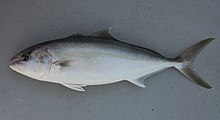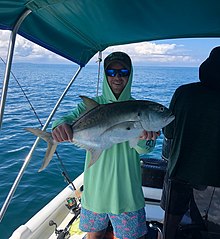Greater amberjack
| Greater amberjack | |
|---|---|

| |
| Scientific classification | |
| Domain: | Eukaryota |
| Kingdom: | Animalia |
| Phylum: | Chordata |
| Class: | Actinopterygii |
| Order: | Carangiformes |
| Family: | Carangidae |
| Genus: | Seriola |
| Species: | S. dumerili
|
| Binomial name | |
| Seriola dumerili (Risso, 1810)
| |
| Synonyms[2] | |
| |

The greater amberjack (Seriola dumerili), also known as the allied kingfish, great amberfish, greater yellowtail, jenny lind, Sea donkey, purplish amberjack, reef donkey, rock salmon, sailors choice, yellowtail, and yellow trevally, is a species of predatory
Description
The greater amberjack is a large predatory fish which has a body colouring which varies from brownish to bluish-grey on the dorsal surfaces contrasting with the silvery-white underparts. A diagonal sooty stripe starts at the snout and runs along the centre of the back

Distribution
The greater amberjack has an almost circumglobal distribution in the world's subtropical and tropical seas and oceans. In the Indian Ocean, it is found along the African coast from South Africa east through the Persian Gulf to Western Australia and southern Japan, reaching the Hawaiian Islands and Micronesia in the Pacific Ocean. It reaches as far south as the island of Tasmania off the coast of Australia. In the western Atlantic Ocean, this species is found around Bermuda and on the North American coast as far north as Nova Scotia extending south as far as Brazil, including the Gulf of Mexico and the Caribbean Sea. In the eastern Atlantic Ocean, it has been recorded as a vagrant as far north as the British Isles and is found off in the Bay of Biscay south to Morocco and in the Mediterranean Sea. It may occur along the west African coast, but may be confused with the similar Seriola carpenteri.[2][3][1][5]
Habitat and biology
Habitat
The greater amberjack is found as solitary individuals or in small to moderate-sized schools, which are
Diet
Greater amberjacks are opportunistic predators when they are adults, which prey on
Breeding

S. dumerli is
The eggs are 1.9 mm (0.075 in) in diameter, and after spawning, the embryos take around 40 hours to develop at 23 °C (73 °F), and the newly hatched 2.9-millimetre (0.11 in) larvae take 31–36 days to develop into juveniles.[2] They can live up to 17 years.[7]

Predators and parasites
Greater amberjack are preyed on by larger fishes including the
Human usage
The greater amberjack is an important food fish and is a commercial quarry species, and the species has been used in
Taxonomy and etymology
The greater amberjack was formally
References
- ^ . Retrieved 14 February 2020.
- ^ a b c d e Froese, Rainer; Pauly, Daniel (eds.) (2019). "Seriola dumerili" in FishBase. August 2019 version.
- ^ a b c d "Seriola dumerili". Fishes of Australia. Museums Victoria. Retrieved 22 November 2019.
- ^ a b c d e f g h "Cultured Aquatic Species Information Programme Seriola dumerili (Risso, 1810)". Food and Agriculture Organization. Retrieved 22 November 2019.
- ^ J.C. Hureau (ed.). "Greater amberjack (Seriola dumerili)". Fishes of the NE Atlantic and the Mediterranean. Marine Species Identification Portal. ETI Bioinformatics. Retrieved 22 November 2019.
- ^ a b c d e "Greater Amberjack". Florida Museum of Natural History. 2017-05-05. Retrieved 22 November 2019.
- ^ "Greater Amberjack". NOAA Fisheries. Retrieved 22 November 2019.
- PMID 35284877.

- ^ "Greater Amberjack". Gulf of Mexico Fishery Management Council. Retrieved 2021-04-12.
- ^ "Greater Amberjack". Take Me Fishing. Retrieved 22 November 2019.
- ^ Eschmeyer, William N.; Fricke, Ron & van der Laan, Richard (eds.). "Caranx dumerili". Catalog of Fishes. California Academy of Sciences. Retrieved 22 November 2019.
- ^ Christopher Scharpf; Kenneth J. Lazara (10 August 2019). "Order CARANGIFORMES (Jacks)". The ETYFish Project Fish Name Etymology Database. Christopher Scharpf and Kenneth J. Lazara. Retrieved 22 November 2019.
- ^ Eschmeyer, William N.; Fricke, Ron & van der Laan, Richard (eds.). "Seriola". Catalog of Fishes. California Academy of Sciences. Retrieved 21 November 2019.

